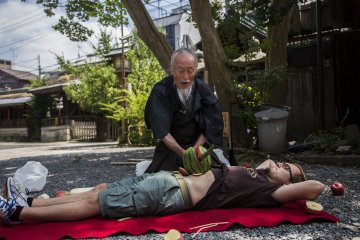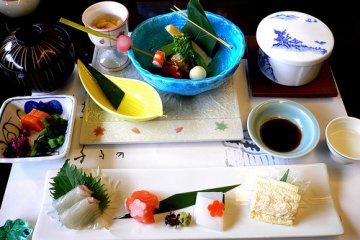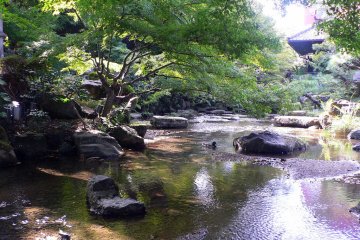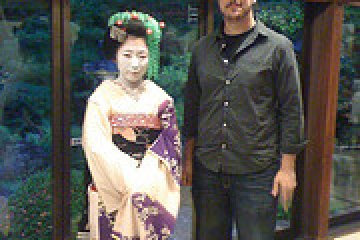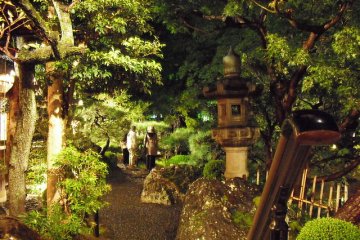One of the highlights of Kyoto is its cuisine, and the best way to experience this is by a Kaiseki lunch or dinner in a beautiful ryokan, overlooking a traditional Japanese Garden. Kaiseki menus usually showcase seasonal flavors and healthy produce that Japanese cuisine is famous for. The chef would carefully select each ingredient and dish, ensuring each dish and course complement each other.
Another highlight in Kyoto is the famous Geishas, traditional dancers and performers that bring to life Japanese art, culture and music from hundreds and thousands years ago.
At the Ganko Takesagawa Nijo Garden Restaurant, you can experience both at once. Set in the grounds of a historic Japanese garden, the gentle streams and mature and manicured trees ease your mind as you prepare yourself for the Kaiseki course. Depending on your appetite and preference you can choose from a number of Kaiseki courses, and the beauty of this is that you don’t have to worry about how to match different dishes or whether there is enough or too much to eat, making it easier for you to relax and enjoy the experience. Seasonal produce may include cherry blossoms in Spring and handpicked mountain vegetables in Fall, as well as different kinds of tofu that Kyoto is famous for, and whose taste is much more flavorsome than those you may have been accustomed to at home. Each course strikes a perfect balance between color, taste and texture, from the sublime silky smooth tofu, the grilled fish with its smokey crispy skin, and Kyoto’s renowned pickled vegetables from its surrounding gardens and mountains.
Even the shape, color and texture of every piece of tableware, from the matcha green and broad bean shaped chopstick holders, to the indigo blue plates in different sizes, is designed and matched to enhance your sensory experience. It is like the chef has used everything in his disposal to create a colorful landscape of a miniature garden of pinks, greens and yellows.
All these healthy ingredients ensure that even after a three or four course meal, you are not weighted down by the meal, as most items are like appetizers, and it may be said that the French and Japanese had perfected the art of degustation courses long before it became popularized around the world.
And to top off your meal at Ganko, there are Geisha Discovery Days where Maiko (apprentice Geisha) perform Japanese dance, with each dance full of historical meaning and deep emotion.
Of course, if you prefer to order a la carte, Ganko has that covered as well. Whether you love udon soba, grilled fish, sashimi tempura or even steak and chips, Ganko has something to suit your appetite. They even have children’s' menus. The sashimi is good though having just came from Tsukiji fish markets the day before I have been spoilt by amazingly fresh fish. For less than 1300 yen you can enjoy a main and dessert with freshly brewed tea and relax in a comfortable and elegant atmosphere with family and friends.
Whilst the menu is in Japanese, all choices have clear pictures so it is easy to order. They even have a children’s’ menu and a tofu based dessert menu, ranging from tofu donuts to tofu cheesecake which is similar to pudding and cheesecake in texture, and annin tofu with fruit which is familiar to anyone who has been to a Cantonese yum cha lunch. For my taste the light and airy tofu donuts are a treat, though this place is not as renowned for its desserts.
While you could possibly have even higher quality food at a Michelin star restaurant or ryokan, this place is great value at probably half the price of the top end restaurants. Also the service and comfort levels are equal if not better than many four star restaurants, especially for families or any medium sized groups, where you can use a private tatami room with simple but exquisite decorations, with a feel of a country ryokan. The kimono clad waitresses are gracious and you feel transported to a more elegant time.
You should also know that while the word “Nijo” is part of the restaurant’s name, it is actually much closer to the nearby Kamogawa river and the Gion district than the Nijo Castle for which the word Nijo is synonymous with. Being a former holiday home for Kyoto’s well to do for over four hundred years, the building blends beautifully with the garden setting. The Takesagawa canal is nearby, and is a great place to stroll after the meal, especially during cherry blossom season.





